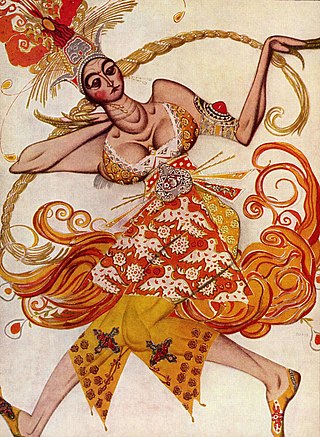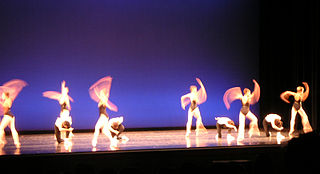
Igor Fyodorovich Stravinsky was a Russian composer and conductor with French citizenship and American citizenship. He is widely considered one of the most important and influential composers of the 20th century and a pivotal figure in modernist music.

The Rite of Spring is a ballet and orchestral concert work by the Russian composer Igor Stravinsky. It was written for the 1913 Paris season of Sergei Diaghilev's Ballets Russes company; the original choreography was by Vaslav Nijinsky with stage designs and costumes by Nicholas Roerich. When first performed at the Théâtre des Champs-Élysées on 29 May 1913, the avant-garde nature of the music and choreography caused a sensation. Many have called the first-night reaction a "riot" or "near-riot", though this wording did not come about until reviews of later performances in 1924, over a decade later. Although designed as a work for the stage, with specific passages accompanying characters and action, the music achieved equal if not greater recognition as a concert piece and is widely considered to be one of the most influential musical works of the 20th century.

George Balanchine was a Georgian-American ballet choreographer, recognized as one of the most influential choreographers of the 20th-century. Styled as the father of American ballet, he co-founded the New York City Ballet and remained its artistic director for more than 35 years. His choreography is characterized by plotless ballets with minimal costume and décor, performed to classical and neoclassical music.

New York City Ballet (NYCB) is a ballet company founded in 1948 by choreographer George Balanchine and Lincoln Kirstein. Balanchine and Jerome Robbins are considered the founding choreographers of the company. Léon Barzin was the company's first music director. City Ballet grew out of earlier troupes: the Producing Company of the School of American Ballet, 1934; the American Ballet, 1935, and Ballet Caravan, 1936, which merged into American Ballet Caravan, 1941; and directly from the Ballet Society, 1946.

The Firebird is a ballet and orchestral concert work by the Russian composer Igor Stravinsky. It was written for the 1910 Paris season of Sergei Diaghilev's Ballets Russes company; the original choreography was by Michel Fokine, who collaborated with Alexandre Benois and others on a scenario based on the Russian fairy tales of the Firebird and the blessing and curse it possesses for its owner. It was first performed at the Opéra de Paris on 25 June 1910 and was an immediate success, catapulting Stravinsky to international fame and leading to future Diaghilev–Stravinsky collaborations including Petrushka (1911) and The Rite of Spring (1913).
Le Baiser de la fée is a neoclassical ballet in one act and four scenes composed by Igor Stravinsky in 1928 and revised in 1950 for George Balanchine and the New York City Ballet. Based on Hans Christian Andersen's short story Isjomfruen, the work is an homage to Pyotr Ilyich Tchaikovsky, for the 35th anniversary of the composer's death. Stravinsky elaborated several melodies from early piano pieces and songs by Tchaikovsky in his score. A commission by Ida Rubinstein from 1927, the ballet was choreographed by Bronislava Nijinska and premiered in Paris on 27 November 1928.

Igor Stravinsky's Violin Concerto in D is a neoclassical violin concerto in four movements, composed in the summer of 1931 and premiered on October 23, 1931. It lasts approximately twenty minutes.

Apollo is a neoclassical ballet in two tableaux composed between 1927 and 1928 by Igor Stravinsky. It was choreographed in 1928 by twenty-four-year-old George Balanchine, with the composer contributing the libretto. The scenery and costumes were designed by André Bauchant, with new costumes by Coco Chanel in 1929. The scenery was executed by Alexander Shervashidze, with costumes under the direction of Mme. A. Youkine. The American patron of the arts Elizabeth Sprague Coolidge had commissioned the ballet in 1927 for a festival of contemporary music to be held the following year at the Library of Congress in Washington, D.C.
Symphony in E-flat is a ballet made by John Clifford to Stravinsky's Symphony in E-flat, Op. 1 (1908). The premiere took place as part of New York City Ballet's Stravinsky Festival, June 20, 1972, at the New York State Theater, Lincoln Center, with Gelsey Kirkland and Peter Martins as the leading dancers.

Agon is a 22-minute ballet for twelve dancers with music by Igor Stravinsky. It was choreographed by George Balanchine. Stravinsky began composition in December 1953 but was interrupted the next year; he resumed work in 1956 and concluded on April 27, 1957. The music was premiered in Los Angeles at UCLA's Royce Hall on June 17, 1957, conducted by Robert Craft. Stravinsky himself conducted the sessions for the work's first recording the following day on June 18, 1957. Agon was first performed on stage by the New York City Ballet at the City Center of Music and Drama on December 1, 1957.
Ode: Elegiacal Chant in Three Parts is an orchestral work from 1943 composed by Igor Stravinsky. Prior to its completion, the score's working title had been Triads.

Karin Anny Hannelore Reinbold von Aroldingen was a German ballet dancer. She danced as a soloist at the Frankfurt Opera Ballet before joining the New York City Ballet in 1962 after receiving a personal invitation from George Balanchine. She was named as one of Balanchine's main beneficiaries in his will. Von Aroldingen retired from New York City Ballet in 1984, having reached the rank of principal dancer in 1972. In her later life, she worked as a répétiteur for the Balanchine Trust, for which she was also a founder, staging his ballets for various companies.
Circus Polka: For a Young Elephant was written by Igor Stravinsky in 1942. He composed it for a ballet production that the choreographer George Balanchine did for Ringling Bros. and Barnum & Bailey Circus. The ballet was performed by fifty elephants and fifty ballerinas. In 1944, Stravinsky published an orchestration of the piece, which is now part of the repertoire of many orchestras.
Symphony in Three Movements is a neoclassical ballet choreographed by George Balanchine to the music of the same name by Igor Stravinsky. The ballet was made for the New York City Ballet Stravinsky Festival in 1972, a tribute to the composer following his death. The ballet premiered on June 18, 1972, at the New York State Theater.
Elegy is a composition by Igor Stravinsky for solo viola composed in 1944. It was dedicated to the memory of Alphonse Onnou, the founder of the Pro Arte Quartet. The score bears no time signature, but the metronome marking sets the tempo at = 56. The opening section is in the style of a chant above a rippling accompaniment. The middle section contains elements of a fugue, though there are never more than two independent voices. After its climax, the Elegy closes with a recapitulation of its opening. The viola is directed to play with mute throughout.
Scherzo à la Russe is a ballet choreographed by George Balanchine to Stravinsky's music of the same name. The ballet was created for New York City Ballet's Stravinsky Festival, a tribute to the composer after his death, and premiered on June 21, 1972, at the New York State Theater, with the two lead roles originated by Karin von Aroldingen and Kay Mazzo.
Scènes de ballet is a suite of dance movements composed in 1944 by Igor Stravinsky. It was commissioned by Broadway producer Billy Rose for inclusion in the revue The Seven Lively Arts that opened at the Ziegfeld Theater on December 7, 1944.
Danses concertantes is the title of a work for chamber orchestra written in 1941–42 by Igor Stravinsky, commissioned by Werner Janssen. Stravinsky's music has been used for eponymous ballets by numerous choreographers attracted by its danceability.
Stravinsky Violin Concerto, originally titled Violin Concerto, is a neoclassical ballet choreographed by George Balanchine to Stravinsky's Violin Concerto. Balanchine had previously choreographed another ballet to the concerto in 1941 for the Original Ballet Russe, titled Balustrade, though it was not revived following a few performances. He then reused the concerto for New York City Ballet's Stravinsky Festival in 1972, a tribute to the composer following his death. The ballet premiered on June 18, 1972, at the New York State Theater.
Duo Concertant is a ballet choreographed by George Balanchine to Stravinsky's score of the same name. The ballet was created for New York City Ballet's Stravinsky Festival, a tribute to the composer a year after his death, and premiered on June 22, 1972, at the New York State Theater, danced by Kay Mazzo and Peter Martins.